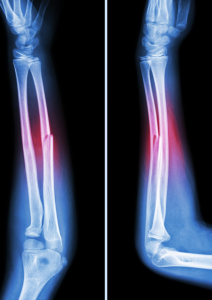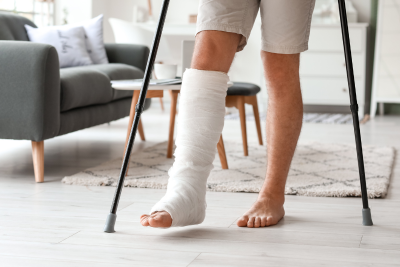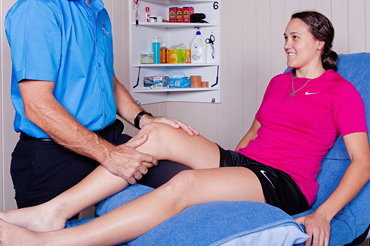Breaking a bone is equally as painful as it is frustrating!
Depending on the type of fracture, you may need some help with various, simple daily activities like dressing, walking or driving for many weeks after your diagnosis.
In this blog, we’ll explore the signs of a fracture and provide some options as to pain relief and treatment, including the role of physical therapy in healing broken bones. We hope this will assist you in alleviating pain and supporting you on your recovery journey.
What is a Fracture?
A fracture, or broken bone, most commonly occurs as a result of a fall, sporting injury or car accident.
The type of fracture can range in severity depending on the force of impact and resulting injury to the surrounding tissues. Small fractures, or stress fractures, can occur with repeated wear, whilst older people with osteoporosis can be prone to fractures, due to a fall or otherwise.
Signs of Fracture
Some common signs of a fracture can include the following –
- Pain with weight bearing or movement of the injured bone
- Pain can be sharp, or an intense ache depending on the break
- Swelling
- Weakness
- Warmth
- Numbness
- Bleeding
- Bruising
- Bone protruding through the skin
- Change to the look/angle of the bone
Diagnosis of a Fracture
Whilst they are generally not life threatening, broken bones do require medical attention.
If you suspect a fracture, you should see your doctor or hospital as soon as possible. They will assess the injured area, check mobility and determine potential injury to the joint or blood vessels. Either an X-ray, CT scan or MRI will be used to diagnose a fracture.
Initial Treatment and Healing
Initially a fracture will be immobilised to allow for optimal bone healing. Treatment will largely depend on the type of fracture, severity and location.
Immobilisation will include the use of a splint, cast and/or sling, and aims to keep the bone aligned, stop it from moving and help with the pain.
If you require internal fixation, surgery is required and may require insertion of metal pins, plates, rods, screws or wires, that may stay in or be removed at a later date.
Generally a bony fracture will take about 6-8 weeks to heal. This time depends on the location and severity of fracture, and the age, level of general health of the patient, and other factors like bone density, or smoking and alcohol consumption.

At-Home Pain Relief Recommendations
There are various at-home remedies to help with pain relief during the healing process.
These include –
Rest and Elevation – Rest is essential in the healing process. Elevate the area as much as possible to reduce swelling and discomfort.
Cold Packs – For either a compression fracture or bone fracture, cold compresses can help reduce pain and swelling in the initial stages.
Pain Medications – Non prescription pain relievers like ibuprofen can help manage pain. Always follow the recommended dosage.
Natural Anti-Inflammatories – There are various natural remedies like turmeric, ginger or omega-3 fatty acids that may help with pain and inflammation.
Immobilisation – Always follow your healthcare provider’s advice on how to immobilise the area to assist in the fastest recovery time.
Diet and Nutrition – A nutrient rich, balanced diet will assist greatly with bone healing. Ensure your diet includes calcium, vitamin D and other essential nutrients.
The Process of Healing
1. Firstly blood will rush to the area to deliver cells to allow your bone to heal and protect your bone.
2. About a week later, a callus starts to form that is collagen-rich bone tissue. This is soft but will turn hard.
3. Then in the following weeks, new bone will start to form and replace callus when new bone-forming cells (osteoblasts) move in. This new bone will completely replace the callus.
4. Brand new bone tissue will then fully repair the break. It will create a much thicker and stronger bone.
Importance of Post Fracture Rehabilitation
While the primary treatment for a broken bone is typically immobilisation and medical intervention, physical therapy plays a crucial role in the recovery process.
There is much more to the healing process than just healing the bone.
Everything above and below the fracture site will also be affected. Very often there will be damaged soft tissue and structures from the initial injury, along with the effects of the immobilisation itself causing joint stiffness and muscle weakness. The non fractured joints and muscles are also a very important part of the rehabilitation process.
Often it can take 12 – 16 weeks to fully return to normal activities after a fracture, but of course this also depends on various factors.
How does Physiotherapy help recover from a broken bone?
Once your doctor or specialist has cleared you to start rehabilitation, your Physiotherapist will get started on returning movement to the affected area. This will usually be within the first 6 weeks following injury.
Your physiotherapist will take a holistic approach, and focus on mobilising all the joints surrounding the fracture site/immobilised area. They will aim to prevent muscle weakness or disuse atrophy, prevent incorrect movement patterns, begin weight bearing when appropriate, and implement a safe and effective home exercise program. Your physio will then work with you to regain full joint range of motion and muscle strength.
Physio can help in a number of ways including –
- Range of Motion – After the bone has healed sufficiently your physio can help with regaining full range of motion. They will gently and gradually mobilise the area, preventing stiffness and muscle atrophy.
- Muscle Strength – Muscles around the fracture site can often weaken during immobilisation. Your Physio will work with you through various exercises, to rebuild strength and prevent muscle loss, to improve overall stability and function.
- Pain Management – Your physio can use various techniques to relieve pain, including soft tissue mobilisation, massage and ultrasound, and offer advice for at-home pain relief.
- Balance and Stability – Physiotherapy helps to improve balance and co-ordination and reduce the risk of further falls or injuries.
- Scar Tissue – Physios can help manage and reduce scar tissue with regards to mobility, after surgical treatment.
- Functional Recovery – Physiotherapists take a holistic approach to help you regain the ability to complete daily activities and tasks, as soon as possible.

Broken Bone Rehabilitation at Sandgate Physical Health Clinic
As you have read, Physiotherapy plays a vital role in the healing process of a broken bone, helping you regain mobility, reduce pain, and enhance your overall quality of life during recovery.
Your Physiotherapist at SPHC will develop a personalised treatment plan that suits your specific injury and needs. With some patience, time, and consistent effort, you can achieve a full recovery and return to your normal activities.
Schedule an appointment at Sandgate Physical Health today!
Read more about Injury Rehabilitation and our Physiotherapy Services.

